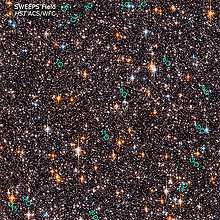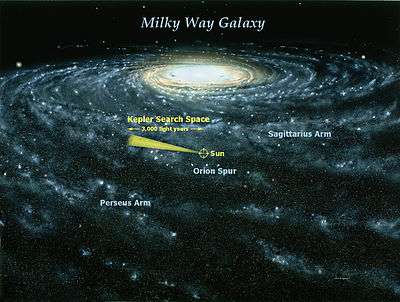Exoplanetary Circumstellar Environments and Disk Explorer
Exoplanetary Circumstellar Environments and Disk Explorer (EXCEDE) is a proposed space telescope for NASA's Explorer program to observe circumstellar protoplanetary and debris discs and study planet formation around nearby (within 100 parsecs) stars of spectral classes M to B.[1] Had it been selected for development, it was proposed to launch in 2019.
| Mission type | Space observatory |
|---|---|
| Website | soweb |
| Mission duration | 3 years nominal (proposed)[1] |
| Orbital parameters | |
| Reference system | Geocentric |
| Regime | Sun Synchronous |
| Semi-major axis | 2,000 km |
| Inclination | 105° |
| Period | 127 min |
| Main | |
| Diameter | 70 cm (28 in)[1] |
| Instruments | |
| Imaging polarimeter | |
Explorers program[1] | |
The spacecraft concept proposed to use a 70 centimeter diameter telescope-mounted coronagraph called PIAA (Phase Induced Amplitude Apodized Coronagraph) to suppress starlight in order to be able to detect fainter radiation of circumstellar dust.[1] Characterizing constitution of such disks would provide clues for planetary formation (mostly in habitable zones), while already existing exoplanets can be detected through their interaction with dust disk. The project's Principal Investigator is Glenn Schneider.[1]
Science goals
The science goals of the concept mission are: [1]
- Explore the amount of dust in habitable zones
- Determining if such a disk interferes with future planet finding missions (dust-scattered starlight causes noise in images of exoplanets[2])
- Determine composition of material delivered to planets: icy and organich-rich particles are important for life.[3]
- Determine fraction of massive planets on large orbits
- Observe how protoplanetary disks make Solar System-like architectures
- Constrain giant planets' composition by measuring their reflectivity[4] EXCEDE would be the first to image (giant) exoplanets distances from their stars similar to ours (0.5-7 AU).[5]
References
- The EXoplanetary Circumstellar Environments and Disk Explorer (EXCEDE). (PDF). Olivier Guyon, Glenn Schneider, Ruslan Belikov, Domenick J. Tenerelli. arXive repository. 10 October 2012. doi:10.1117/12.927188
- "Future Mission Impacts?". Glenn Schneider. Retrieved 25 February 2012.
- "Delivery of Planet Veneers". Glenn Schneider. Retrieved 25 February 2012.
- "CS Disks: Signposts of Planets". Glenn Schneider. Retrieved 24 February 2012.
- "Cool Giant Exoplanets". Glenn Schneider. Retrieved 25 February 2012.

.png)

